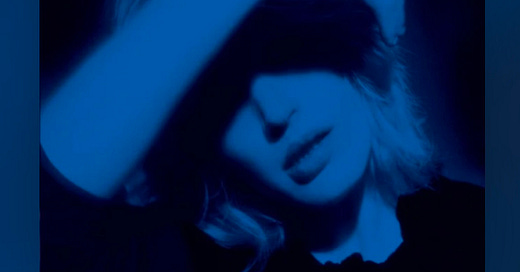Through the Mirror Blue – On Marianne Faithfull and the Cracks in Life
Rhonda listens to the late singer reading The Lady of Shallot and has a good old bawl.
We seem to write a lot about crying, the travel wife and I. Tracey recently wrote about crying on planes – one of our favourite pastimes, apart and together. And last year I wrote about crying on my Ayurvedic retreat in India and even trying not to cry in the beauty salon. We’re obsessed with crying, it seems. Menopausal, mucho?
In Australia over this past Christmas and New Year, I fell into the habit of planning my work so I could get down the beach about 4pm every day. Lying down by the rock pools, I’d indulge myself in a good old blubber behind my shades before taking a swim or having a nap.
It was everything – homesickness for two of my kids back at home, the aftermath of a truly extraordinary trip to Antarctica (a place that can't help but change you), jet-lag, divorce, heartbreak, inner conflict, gratitude, and joy. A crazy mix. How not to cry?
What has this all got to do with Marianne Faithfull, you may be asking? Well Marianne Faithfull was pure goddess, a real warrior woman who went through all sorts of horrible things and came out stronger and more herself.
Things Marianne Faithfull survived: A charity-assisted childhood and recurrent tuberculosis, three marriages, being a muse to one of the world’s most famous men, an eating disorder, living on a wall in Soho, cocaine and heroin addictions, three miscarriages and a stillbirth, losing custody of her daughter, a suicide attempt, the suicide of a lover, breast cancer, hepatitis, emphysema, and pneumonia brought on by Covid.
She not only survived, but she survived to the point when she could finally say, in 2013, AT THE AGE OF 66: “I’ve got to where I’ve always wanted, I just feel more myself… and I’ve learned not to care what other people think. It’s happened slowly, very slowly… But I did it.”
And surely feeling more oneself is everything? Although maybe there is a lot of crying to be done to get there… (Although Marianne Faithfull herself claimed that she never cried).
Marianne Faithfull worked with lots of other great musicians, including PJ Harvey, Bowie, Jarvis Cocker, Dave Stewart, Beck, Billy Corgan and Étienne Daho. She was also an accomplished actress who worked with, among many others, Glenda Jackson, Sofia Coppola, Jean-Luc Godard and Alain Delon. In among her hugely eclectic array of roles were a lesbian Florence Nightingale, God, the Devil, and a 60-year-old widow who goes to work in a sex club to pay for treatment for her sick grandson.
Too many of my creative idols have died recently: Paul Auster, David Lynch, Marianne. When I heard Marianne Faithfull had walked through the mirror into the next realm or reality, whatever that may be, I spent the evening re-listening to her remarkable Covid-survival album She Walks in Beauty, in which she reads English romantic poems set to music by Warren Ellis, Nick Cave, Brian Eno and others – an album beautifully described by critic Helen Brown as being like a 'Viking funeral barge' from a 'pirate crew of against-the-odds survivors’.
If you're never heard it, you should give it a spin – it will shatter you. Especially the death scene of the Lady of Shallot, who, after becoming ‘half sick of shadows’ – the human life and interactions she sees through her ‘mirror clear’ – brings a curse upon herself by letting herself develop yearnings for Lord Lancelot out in the real world.
As the Lady of Shallot escaped from her tower, ‘the mirror cracked from side to side’ and she died of exposure while floating down the river to Camelot in a boat.
And that is how I found myself crying all night, obviously not really about a dead figure of Arthurian legend and not even really because Marianne Faithful had died, but out of gratitude that she ever existed and that we can still and forever listen to what another critic, Alanna Nash, described as the ‘cracked and halting rasp, the voice of a woman who's been to hell and back on the excursion fare which, of course, she has.’
She Walks in Beauty will shatter you, like it shatters me, but in a good way. Sometimes we all need be broken, so we can put ourselves back together again in a different way, like a Japanese ceramic repaired through the technique of kintsugi – filling the seams with powdered gold. As Marianne showed us, sometimes the poetry of life, its true beauty, is found in the cracks.






Enjoyed this article - thank you! I have never heard it - you have persuaded me to listen to it:)
Another one hits the dust to quote another deceased singer !!
Wow I shall definately listen to She walks in Beauty and let my soul be stirred.
Thank you Rhonda.